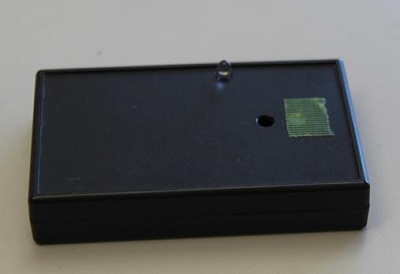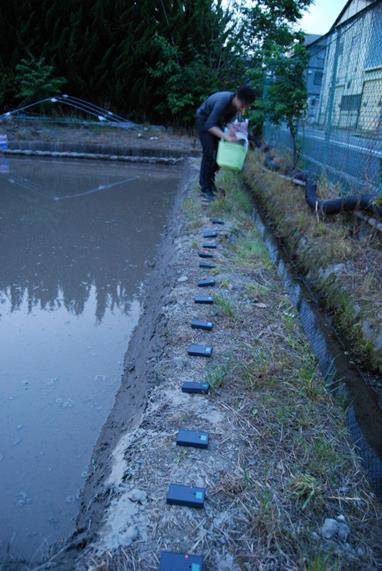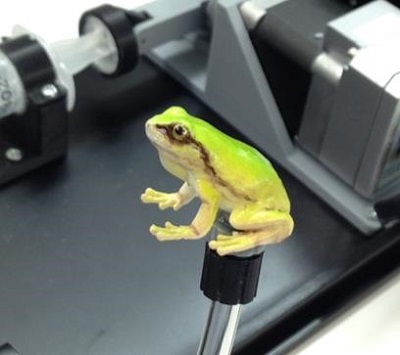TSUKUBA FUTURE
#088 Enticed by the Calls of Frogs
Assistant Professor AIHARA Ikkyu, Faculty of Engineering, Information and Systems

The chorus of frogs is often heard in Japan. In general, male frogs produce calls to attract conspecific females. Such behavior is well known, but there have been few studies to identify the vocalizations of frogs in their natural habitat. Professor Aihara is developing a novel method to investigate the acoustic communication methods of frogs.
Interests in physics and frogs. But is there any way to combine these two? Prof. Aihara seems to have found an answer to this conundrum. Having entered Kyoto University in order to study physics, he joined a group devoted to the observation of wild animals and plants. This was a gathering of people with a common interest in wildlife who would travel to various regions to lose themselves in observations of the animals and plants. Prof. Aihara has been very fond of frogs since childhood. Once, on a trip to the Oki Islands, he was entranced by the sight of many frogs near the water in a terraced rice paddy, calling in synchronization. He then decided to determine the timing with which the individual frogs produced their calls.
One problem was how to record the calls of the frogs lining the edge of a rice field at sunset. After various false starts, a mechanically-minded colleague developed a compact device with an LED that would light up when a call was detected nearby. This gadget was dubbed the "Firefly". These devices were installed along a rice paddy footpath at intervals of 40 cm. When dusk approached and legions of Japanese tree frogs gathered by the waterside and began to chorus, the Firefly would begin to flicker as well. This was recorded on video. The analysis of the video demonstrated that nearby frogs called in alternation, avoiding overlap of their calls. This result was in agreement with a mathematical model postulating that nearby individuals mutually influence the timing (phase) of vocalizations. A frog chorus consists of calls by males to attract females. Therefore, call alternation could be a strategy of male frogs to effectively advertise themselves to females. Such pursuit of self-interest by individuals results in a grand chorus that might be produced by two groups singing in alternation.
An international joint research effort is also underway in Panama. The male tungara frog, with a body length of about 3 cm, inflates its vocal sac dramatically and produces a call that sounds like "tun-gara." The louder and more numerous the complex "gara" components in its call, the more attractive a male frog is to the females. However, the frog's call also attracts bats that prey on the tungara frog, and midges that suck its blood. Prof. Aihara and colleagues arranged their Firefly devices and recorded the pattern of the frogs' calls, and simultaneously positioned devices at each location to catchmidges. As a result, they found that male frogs that more frequently called with a larger number of the complex "gara" components were visited not only by female frogs, but by a larger number of the midges as well. The chorus in unison of frogs has an aspect of competition among males to attract females. The tungara frog seems to be resigned to this negative aspect, in which the male frogs that have success among the females are also midge-ridden. It may be that the calling pattern is constrained by considerations of these positive and negative aspects of vocalization--an issue that remains an important research theme. In the wild outdoor areas where research takes place, there are also plenty of mosquitoes that feed on human blood. But researchers do not use mosquito repellent, which would be likely to affect the study results. Scientific research is not always a pleasant endeavor.

Prof. Aihara's secret weapon, the Firefly. It measures 6 cm × 10 cm × 2 cm; a patent has already been published.

Installation of Firefly units.
In order to further investigate the relationships among frog species, Prof. Aihara and his colleagues have also developed a new device that flashes upon detecting only sounds of a specific frequency. Using this device, it is possible to identify the calls of different frog species, and have the device flash accordingly. In addition, a frog robot that is a dead ringer for a tree frog, and that inflates its vocal sac in the same way, is also being constructed together with coworkers. The plan is to display the robot to females and try to determine the important features of calls that attract them the most. Apart from this, Prof. Aihara is also investigating the echolocation behavior of bats. Bats emit ultrasound and listen to the echoes to detect the positions of obstacles and of flying insects such as mosquitoes and moths that are their prey, even enabling bats to detect how their prey fly. He is also interested in determining what kind of flight paths groups of bats take to efficiently capture their prey. He has also begun research on the speed control of birds when they land, together with speed-control specialist Prof. Toru Kawabe and students in the same laboratory. For example, they are attempting to analyze birds' speed-control technique by filming them through two fixed-point cameras.
Recently, Prof. Aihara has also expanded his studies to include marine organisms such as aquatic isopods that form colonies in barnacles. The males of the species emit a squeaking sound, but it is not yet known for what purpose. Prof. Aihara appears truly happy to describe his research that uses physics to observe and analyze his favorite animals, and the scope of his research will likely continue to expand.

A frog robot, being developed jointly with Takaharu Oda of Full Dimensions Studio. Equipped with a miniature motor, air causes the throat to expand.
Article by Science Communicator at the Office of Public Relations



